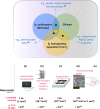Recent advances in microresonators and supporting instrumentation for electron paramagnetic resonance spectroscopy
- PMID: 36319314
- PMCID: PMC9632321
- DOI: 10.1063/5.0097853
Recent advances in microresonators and supporting instrumentation for electron paramagnetic resonance spectroscopy
Abstract
Electron paramagnetic resonance (EPR) spectroscopy characterizes the magnetic properties of paramagnetic materials at the atomic and molecular levels. Resonators are an enabling technology of EPR spectroscopy. Microresonators, which are miniaturized versions of resonators, have advanced inductive-detection EPR spectroscopy of mass-limited samples. Here, we provide our perspective of the benefits and challenges associated with microresonator use for EPR spectroscopy. To begin, we classify the application space for microresonators and present the conceptual foundation for analysis of resonator sensitivity. We summarize previous work and provide insight into the design and fabrication of microresonators as well as detail the requirements and challenges that arise in incorporating microresonators into EPR spectrometer systems. Finally, we provide our perspective on current challenges and prospective fruitful directions.
Figures









Similar articles
-
Resonators for Clinical Electron Paramagnetic Resonance (EPR).2020 Aug 9. In: Berliner LJ, Parinandi NL, editors. Measuring Oxidants and Oxidative Stress in Biological Systems [Internet]. Cham (CH): Springer; 2020. Chapter 10. 2020 Aug 9. In: Berliner LJ, Parinandi NL, editors. Measuring Oxidants and Oxidative Stress in Biological Systems [Internet]. Cham (CH): Springer; 2020. Chapter 10. PMID: 33411447 Free Books & Documents. Review.
-
New directions in electron paramagnetic resonance spectroscopy on molecular nanomagnets.Top Curr Chem. 2012;321:199-234. doi: 10.1007/128_2011_303. Top Curr Chem. 2012. PMID: 22076082 Review.
-
Sensitive surface loop-gap microresonators for electron spin resonance.Rev Sci Instrum. 2010 Oct;81(10):104703. doi: 10.1063/1.3488365. Rev Sci Instrum. 2010. PMID: 21034106
-
Use of multi-coil parallel-gap resonators for co-registration EPR/NMR imaging.J Magn Reson. 2007 Jan;184(1):29-38. doi: 10.1016/j.jmr.2006.09.014. Epub 2006 Oct 6. J Magn Reson. 2007. PMID: 17029883
-
New ceramic EPR resonators with high dielectric permittivity.J Magn Reson. 2008 Nov;195(1):52-9. doi: 10.1016/j.jmr.2008.08.015. Epub 2008 Sep 6. J Magn Reson. 2008. PMID: 18815061
Cited by
-
X-Band Single Chip Integrated Pulsed Electron Spin Resonance Microsystem.Anal Chem. 2024 Sep 10;96(36):14516-14523. doi: 10.1021/acs.analchem.4c02769. Epub 2024 Aug 27. Anal Chem. 2024. PMID: 39190870 Free PMC article.
-
Microfluidic-Integrated Chip Resonators for Electron Spin Sensing in Submicromolar, Submicroliter Solutions.Anal Chem. 2024 Oct 29;96(43):17071-17077. doi: 10.1021/acs.analchem.4c00464. Epub 2024 Oct 15. Anal Chem. 2024. PMID: 39405519
-
Terahertz magnetic response of plasmonic metasurface resonators: origin and orientation dependence.Sci Rep. 2024 Jul 3;14(1):15305. doi: 10.1038/s41598-024-65804-9. Sci Rep. 2024. PMID: 38961198 Free PMC article.
-
Order-of-magnitude SNR improvement for high-field EPR spectrometers via 3D printed quasi-optical sample holders.Sci Adv. 2023 Sep 22;9(38):eadi7412. doi: 10.1126/sciadv.adi7412. Epub 2023 Sep 20. Sci Adv. 2023. PMID: 37729398 Free PMC article.
-
Microwave field mapping for EPR-on-a-chip experiments.Sci Adv. 2024 Aug 16;10(33):eado5467. doi: 10.1126/sciadv.ado5467. Epub 2024 Aug 16. Sci Adv. 2024. PMID: 39151005 Free PMC article.
References
-
- Weil J. A. and Bolton J. R., Electron Paramagnetic Resonance: Elementary Theory and Practical Applications, 2nd ed. (John Wiley & Sons, 2007).
-
- Schweiger A. and Jeschke G., Principles of Pulse Electron Paramagnetic Resonance (Oxford University Press, 2001).
-
- Lenahan P. M. and J. F. Conley, Jr., “What can electron paramagnetic resonance tell us about the Si/SiO2 system?,” J. Vac. Sci. Technol. B 16(4), 2134 (1998). 10.1116/1.590301 - DOI
-
- Biskup T., “Doping of organic semiconductors: Insights from EPR spectroscopy,” Appl. Phys. Lett. 119(1), 010503 (2021). 10.1063/5.0054685 - DOI
MeSH terms
Grants and funding
LinkOut - more resources
Full Text Sources

